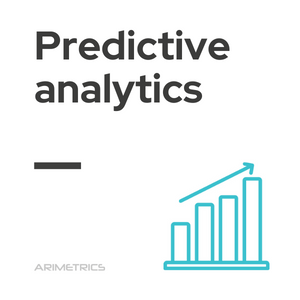Definition:
Predictive analytics encompasses a variety of statistical techniques from predictive modeling, machine learning, and data mining that analyze current and historical facts to make predictions about future or other unknown events. It is considered a form of advanced analytics that implements statistical techniques, algorithmic programming and analytical queries. With the emergence of big data this form of analysis has grown together since the presence of large masses of information has brought with it greater opportunities for analysis.
Predictive models for predictive analytics
In business, predictive models exploit patterns found in historical and transactional data to identify risks and opportunities. These models capture relationships between many factors that allow the assessment of the risk or potential associated with a particular set of conditions, to guide decision-making for potential transactions.
The defining functional effect of these technical approaches is that predictive analytics provides a predictive (probability) assessment for each individual (customers, employees, products, components, machines or other organizational unit) in order to determine, inform, or influence organizational processes that pertain to the other side of a large number of people, such as in marketing, credit risk assessment, fraud detection, manufacturing….
Predictive analytics is used in current science, marketing, financial services, insurance, telecommunications, retail, travel, and other fields.
Advantages of predictive analytics
Predictive analytics offers multiple benefits to organizations that implement it.
- It enables more informed, data-driven decision making, reducing uncertainty and improving forecasting accuracy. In addition, it helps identify hidden trends and patterns that may not be evident to the naked eye, allowing companies to anticipate market changes and adapt their strategies accordingly.
- Resource optimization. By forecasting future demand and behavior, organizations can allocate resources more efficiently, minimizing costs and maximizing return on investment (ROI). In addition, predictive analytics can improve the customer experience by personalizing offers and services, which in turn can increase customer loyalty and satisfaction.
Challenges of predictive analytics
Despite its many advantages, predictive analytics also faces several challenges.
- Data quality and completeness. Predictive models require accurate and complete data; any inconsistency or lack of information can lead to erroneous results and poorly informed decisions.
- Technical complexity involved in the implementation of these techniques. Organizations need to have personnel trained in data analysis and statistics, as well as adequate tools to perform the analysis.
- Interpretation of the results can be complicated, and it is essential that decision makers understand the implications of the predictions in order to use them effectively.
- Ethical and privacy concerns related to the use of data, especially when dealing with sensitive customer information. Companies must ensure that they comply with relevant regulations and handle data responsibly to maintain consumer trust.
Predictive analytics in digital marketing
Predictive analytics has transformed digital marketing by enabling companies to anticipate consumer behavior and optimize their marketing strategies. Using data analytics techniques, organizations can identify patterns in user behavior, allowing them to segment audiences more effectively and personalize advertising campaigns. One of the most common applications of predictive analytics in marketing is predicting a customer’s likelihood of conversion. By analyzing historical data, such as previous interactions, purchases and website behavior, companies can identify which users are most likely to make a purchase and target their marketing efforts to them. This not only improves the efficiency of campaigns, but also increases ROI. In addition, predictive analytics enables customer experience optimization. By understanding users’ preferences and needs, companies can offer personalized product or service recommendations, which increases customer satisfaction and fosters brand loyalty. For example, e-commerce platforms use recommendation algorithms based on user behavior to suggest products that might interest them. However, to take full advantage of predictive analytics in digital marketing, companies must ensure they have high-quality data and appropriate analytics tools. In addition, it is critical to address data privacy concerns and ensure compliance with relevant regulations to maintain consumer trust.
Tools for predictive analytics in digital marketing
Predictive analytics in digital marketing relies on various tools that allow companies to analyze data, identify patterns and predict future consumer behavior. Below are some of the most popular and effective tools in this field:
- Google Analytics: One of the most widely used tools for web data analysis. It offers advanced predictive analytics features that allow marketers to predict user behavior, identify trends and optimize advertising campaigns. Its integration with Google Ads facilitates the creation of more effective campaigns based on historical data.
- IBM Watson Analytics: A data analytics platform that uses artificial intelligence to deliver predictive insights. It allows users to explore data intuitively and generate predictive models that can be applied to various digital marketing strategies, from audience segmentation to sentiment analysis.
- Salesforce Einstein: This is an artificial intelligence tool integrated into the Salesforce platform that enables predictive marketing analytics. It provides personalized recommendations and predictions about customer behavior, which helps optimize interactions and improve the user experience.
- HubSpot: It is an inbound marketing platform that includes predictive analytics tools. It allows companies to analyze the behavior of leads and customers, predict their likelihood of conversion and customize marketing strategies based on that data.
- SAS Advanced Analytics: Offers a range of data analysis tools, including predictive modeling capabilities. This tool is ideal for companies looking to perform complex analysis and gain deep insights into customer behavior and market trends.
- RapidMiner: A data science platform that allows users to perform predictive analytics without programming. Its intuitive interface makes it easy to create predictive models, making it a popular choice among marketers who want to leverage data analytics to improve their strategies.
Choosing the right tool will depend on the specific needs of each company, as well as its budget and level of expertise in data analysis. By using these tools, organizations can make more informed and effective decisions in their digital marketing campaigns.

